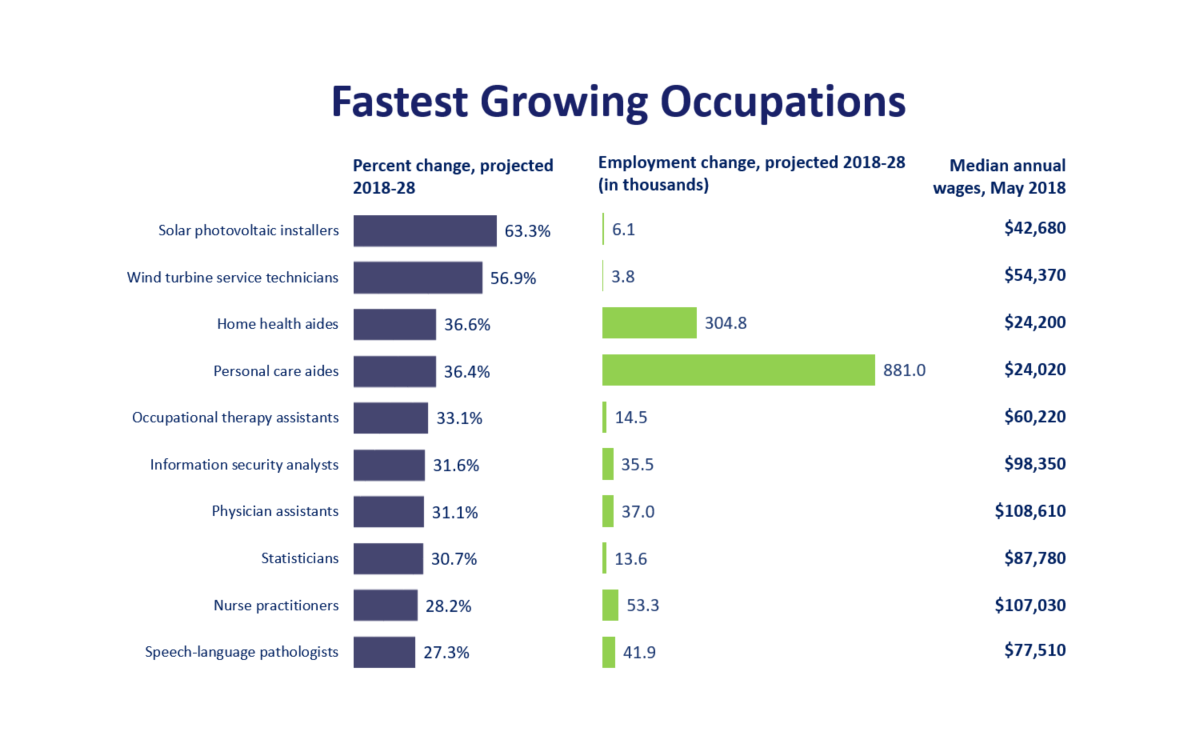With the year 2020 upon us, we are surrounded by references and analogies about perfect vision, seeing the future, and the like. So, to join in with the crowd of advantage takers, I hope it isn’t too cliché to editorialize on three predictions for home care as we enter this new decade, one incidentally that will see 10,000 people turn 65 each day resulting in many implications for the senior care industry. Marry this with the stat that those over the age of 90 are the fastest-growing age demographic, and you really find yourself ready to examine the future of home care in this new year! Let’s buckle down.
Prediction #1: Demand will continue and finding excellent caregivers will remain the industry focus.
Okay, here’s an “easy pickings” prediction to start. The Bureau of Labor Statistics predicts Personal Care Aide will continue to occupy a top spot on career growth charts, with demand rising by 881,000 between 2018 and 2028. In the graph below, even without looking at the details, the magnitude of growth for this specific job in America is apparent.
These labor statistics have been written and talked about for quite some time in the senior services industry. Many cite the avalanche of demand but answers on how to meet that demand are harder to come by – most likely because no one wants to be the bearer of bad news.
To be successful, we must not only acknowledge the reality but also identify ways to thrive during such challenges. For Family Resource, this means investing further into more sophisticated recruiting methods and retaining top talent. In 2019 alone, our agency saw a 20% rise in staff retention allowing for a record-breaking year of more than one million hours of care. How did we do it? Well, that’s part of our super-secret-can’t-tell formula… okay, it’s not quite that dramatic.
Bottom line: employers must be prepared to pay better, design better benefits, provide more customized job experiences, listen to and use employee engagement tactics, all to ensure services are not disrupted by the inability to staff the demand. The trade-off is the cost of home care services, which are widely preferred over alternative long-term care solutions by seniors, will continue to rise in order to fund employee recruitment and retention initiatives.
Sadly, the expense of quality one-on-one care may be out of reach for an ever-increasing population with multiple chronic illnesses and disabilities that need this assistance. Family Resource embraces strategies to address the cost problem: public policy reforms and technology, which happen to be my next two predictions.
Prediction #2: Increased awareness amongst policymakers regarding the value of home care.
At times in the not-so-distant past, home care industry insiders felt like the first to see a hole in the boat and desperately sound the alarm to warn those around them, only to watch in disappointment as the vessel takes on water with most of the passengers giving it no heed. But is it too late to save a sinking ship?
Thankfully, ever-increasing attention is being afforded to the expected need for long-term care services and the army of personal care professionals who will be needed to provide care. Major steps in the right direction include the Centers for Medicare and Medicaid (CMS) permitting Medicare Advantage plans to now offer home care services as a supplemental benefit and Washington State’s new Long Term Care Trust Act which provides state taxpayers with coverage similar to commercial long-term care insurance.
Why so much interest? Simple: Medicaid is the largest single-payer for home care services throughout the country. With incidences of complex medical conditions and lifespan rising simultaneous to the cost pressures for home care services, the financial burden on government payers inevitably increases.
The solution: Public policy that shifts cost or incentivizes individuals and families to engage in more proactive long-term care planning measures. Members of the Family Resource team, myself included, have walked the halls of Congress to lobby for support on such measures including some that have not yet passed.
One example is the Credit for Caring Act which would provide a tax credit for families who finance their own long-term care needs. With each step, we certainly are raising the public profile for these conversations on a national level, yet even more, awareness is needed to address this impending crisis.
Prediction #3: Technology will play an important role in providing high-quality care.
Markets and media alike fawn over anything tech-related. Why? Perhaps because we often see technology as the great answer to all our ills. Based on the sheer number of technology innovations focused on the home, there’s no indication of this trend slowing. Family Resource believes technology can serve two main functions of in-home care.
The first, in relation to issues previously discussed, is namely cost. The more hours per day human-to-human service is deemed necessary, it’s inherently more expensive. We envision technology, while never fully replacing human caregiving, will supplement it with remote monitoring, data gathering, passive risk assessment, and more effective deployment of our human caregivers. As our country struggles to obtain and retain enough caregivers to meet the growing demand, this use case may very well be an absolute necessity.
Second, technology can improve outcomes for clients and drive down overall healthcare costs. In this case, we envision improved awareness of needed interventions to prevent injury or exacerbate illness. Technology will help us better detect – and in a more timely manner – signs, symptoms, trends and determining factors to then equip our caregivers to provide the most appropriate care or seek the inclusion of other healthcare providers. Already, it’s estimated that home care prevents as much as $50 billion in unnecessary hospital care through compliance with chronic disease management, fall prevention, better nutrition, and social and mental health benefits from the meaningful relationships formed between client and caregiver.
This last reason, the enhanced quality of life from person-to-person contact, is the driving rationale as to why we believe technology is unlikely to ever fully replace the human caregiver, but it can offer enhancement. At Family Resource we are collecting and analyzing data sets from our thousands of clients to better our practices for the population we serve, namely those with multiple co-morbidities and functional limitations, a population that is the focus of many in the healthcare continuum right now.
Home care is uniquely positioned to collect this data given our exposure and access to the day-to-day activities of this highest of all risk stratifications – access that no other entity in our healthcare continuum, government, or community has. The opportunities this presents for the industry and our country are fast-approaching and exciting. I’m proud to be part of a team that has long pioneered innovation and best practice, even without the influence of sophisticated technology, but technology will make this effort so much more impactful.
So, there you have it, my top three predictions. While I have additional predictions, I’ve probably already surpassed the overarching point at the outset of this new decade: Home Care is changing along with the rest of healthcare and we are confronted with the need to continue to change and innovate. An important element of Family Resource’s mission is to be “recognized leaders in-home care.” Given this, we commit to staying positioned on the front lines, full bore into the fray to shift the understanding, policies, and utilization of home care as an integral element of our healthcare system.







